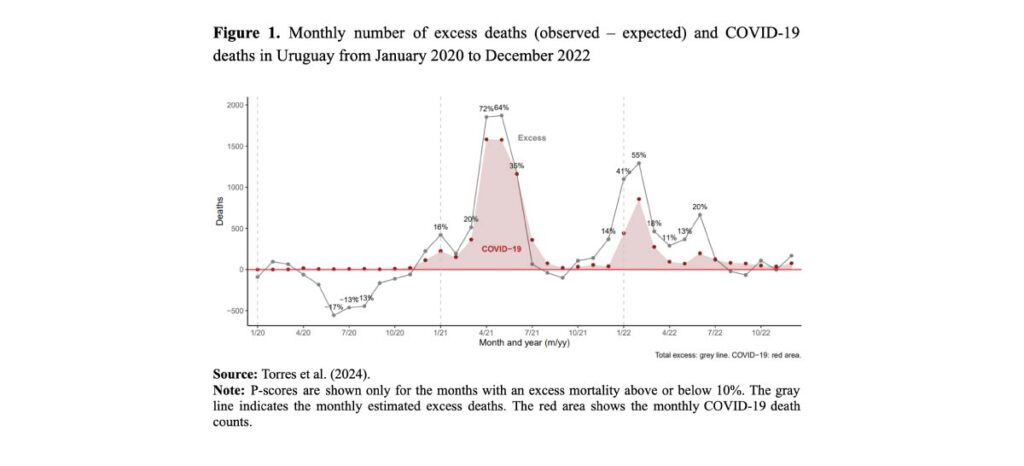In 2020, Latin America became the epicenter of the COVID-19 pandemic, and the number of deaths increased dramatically. Meanwhile, Uruguay experienced lower mortality levels than the previous year despite a non-mandatory lockdown. Catalina Torres and Mariana Paredes describe how this advantage was lost in the two following years, as the number of deaths soared.
The context: COVID-19 in Latin America
Latin America was one of the world regions most affected by the COVID-19 pandemic, accounting for 8.5% of the global population but 27% of all COVID-19 deaths by mid-2022 (Larrain et al. 2023). With a dramatic increase in the number of deaths, especially in Brazil, the region was declared the epicenter of the pandemic in May 2020 by the World Health Organization. The rapid spread of the virus throughout the region resulted in some of the highest levels of excess mortality worldwide in the year 2020. For example, in Peru, Ecuador, and Mexico, the numbers of observed deaths were 153%, 80% and 61% above the expected levels for the year 2020, respectively (Karlinsky and Kobak 2021). This metric, known as P-score, measures the relative change in total mortality by comparing the observed number of deaths against the expected number under “normal” conditions. Lima et al. (2021) estimate that in 2020, 10.9 years of life were lost to the pandemic in Peru, 7.9 years in Ecuador and 5.5 years in Mexico, despite a younger (but rapidly ageing) population age structure than in most other world regions. Social inequalities have been pointed up as important determinants of the severe impact of the COVID-19 pandemic in Latin America (Cid and Marinho 2022).
While the death toll increased massively in most Latin American countries during 2020, the first year of the pandemic, it declined instead in Uruguay, as well as in a handful of other countries around the world (Australia, New Zealand and Norway; Karlinsky and Kobak 2021). Yet, mandatory lockdown was not decreed in Uruguay; instead, the authorities called upon citizens to adhere to social distancing, which they called “responsible freedom”. In addition, several non-pharmaceutical measures were implemented by the government, guided by a group of scientific experts.
Mortality changes in Uruguay in 2020-2022
In a recently published study (Torres et al. 2024), we showed that, in comparison with the year 2019, life expectancy increased in Uruguay in 2020, for both sexes, by almost 10 months. The relatively few COVID-19 fatalities of that year, concentrated mainly in the month of December (Figure 1), were not enough to offset the general survival improvements of the country, mainly driven by mortality reductions among people of ages 65+, possibly benefiting from the battery of preventive measures implemented in the first year of the pandemic.

Conversely, 2021 and 2022 showed large peaks in the estimated number of excess deaths as well as COVID-19 deaths. The annual P-scores for those years rose to almost 19% and 13% respectively. These figures, although much less dramatic than those of countries like Peru, Ecuador and Mexico in 2020, as mentioned above, were unprecedented in Uruguay. With respect to the year 2019, Uruguayan life expectancy declined by about 2 years in 2021, dropping from 81.14 to 79.21 years for females and from 73.43 to 71.37 years for males. The 2022 losses were smaller but still substantial, especially for females (–1.34 years compared to 2019, vs. –0.66 years for males).
The worst months were April and May of 2021 (autumn in the southern hemisphere), when most excess deaths can be attributed to COVID-19. The following, milder mortality peak is observed in January and February of 2022 (summer), which contrasts with the experience of other countries where COVID-19 mortality was lowest in summer and highest in winter (Torres et al. 2023). This result could be related to the relaxation of mobility restrictions in Uruguay during the summer holidays. A third, smaller peak is observed in June 2022 (winter), when most excess deaths were related to causes other than COVID-19.
In comparison with other selected countries, Uruguay’s monthly excess mortality profile during the first pandemic year more closely resembles the paths followed by countries like Australia and New Zealand, which also had a deficit of deaths in 2020 (Karlinski and Kobak 2021). However, 2021 tells a different story, with a pattern more similar to that of its neighbors, Argentina and Brazil.
Why the shift from a deficit to an excess of deaths in Uruguay?
The success of Uruguay during the first pandemic year has been attributed, in part, to the joint efforts of the scientific community and the authorities. The latter were receptive and rapidly implemented the recommendations of the former, especially in 2020 (Taylor 2021). Furthermore, the testing, tracing and isolating strategy was particularly effective in 2020, when most people took social distancing and other official recommendations very seriously, even though lockdown was never mandatory in the country.
Starting in May 2021, however, due in part to the increase in vaccination coverage and in part to the general fatigue with the restrictions that was beginning to surface in society, the battery of preventive measures was progressively relaxed. Too early, maybe, considering that the new “Gamma variant” – which originated in Brazil – was in circulation in the first months of that year. Furthermore, the “pool” of vulnerable people may have been larger than usual in 2021, thanks to the lives saved in 2020, mainly among people of advanced age.
References
Karlinsky, A., Kobak, D. (2021). Tracking excess mortality across countries during the COVID-19 pandemic with the World Mortality Dataset. elife, 10, e69336.
Cid C., Marinho M.L. (2022). Dos años de pandemia de COVID-19 en América Latina y el Caribe: reflexiones para avanzar hacia sistemas de salud y de protección social universales, integrales, sostenibles y resilientes. Documentos de Proyectos (LC/TS.2022/63), Santiago, Comisión Económica para América Latina y el Caribe (CEPAL).
Larrain, N., Di Paolantonio, G., Raitzik Zonenschein, T., Naik, R., Guanais, F. (2023), “The impact of the COVID-19 pandemic on Latin American and Caribbean healthcare systems”, in Health at a Glance: Latin America and the Caribbean 2023, OECD Publishing, Paris, https://doi.org/10.1787/1dd81269-en.
Lima, E. E., Vilela, E. A., Peralta, A., Rocha, M., Queiroz, B. L., Gonzaga, M. R., Piscoya-Díaz, M., Martinez-Folgar, K., García-Guerrero, V., Freire, F. H. (2021). Investigating regional excess mortality during 2020 COVID-19 pandemic in selected Latin American countries. Genus, 77(30).
Taylor L. Why Uruguay lost control of COVID. Nature 2021; 595(7865): 21.
Torres, C., García, J., Meslé, F., Barbieri, M., Bonnet, F., Camarda, C. G., … & Robine, J. M. (2023). Identifying age-and sex-specific COVID-19 mortality trends over time in six countries. International Journal of Infectious Diseases, 128, 32-40.
Torres, C., Prieto Rosas, V., De Armas, G., Paredes, M. (2024). The impact of the COVID-19 pandemic on mortality in Uruguay from 2020 to 2022. Demographic Research, 51, 911-926.


